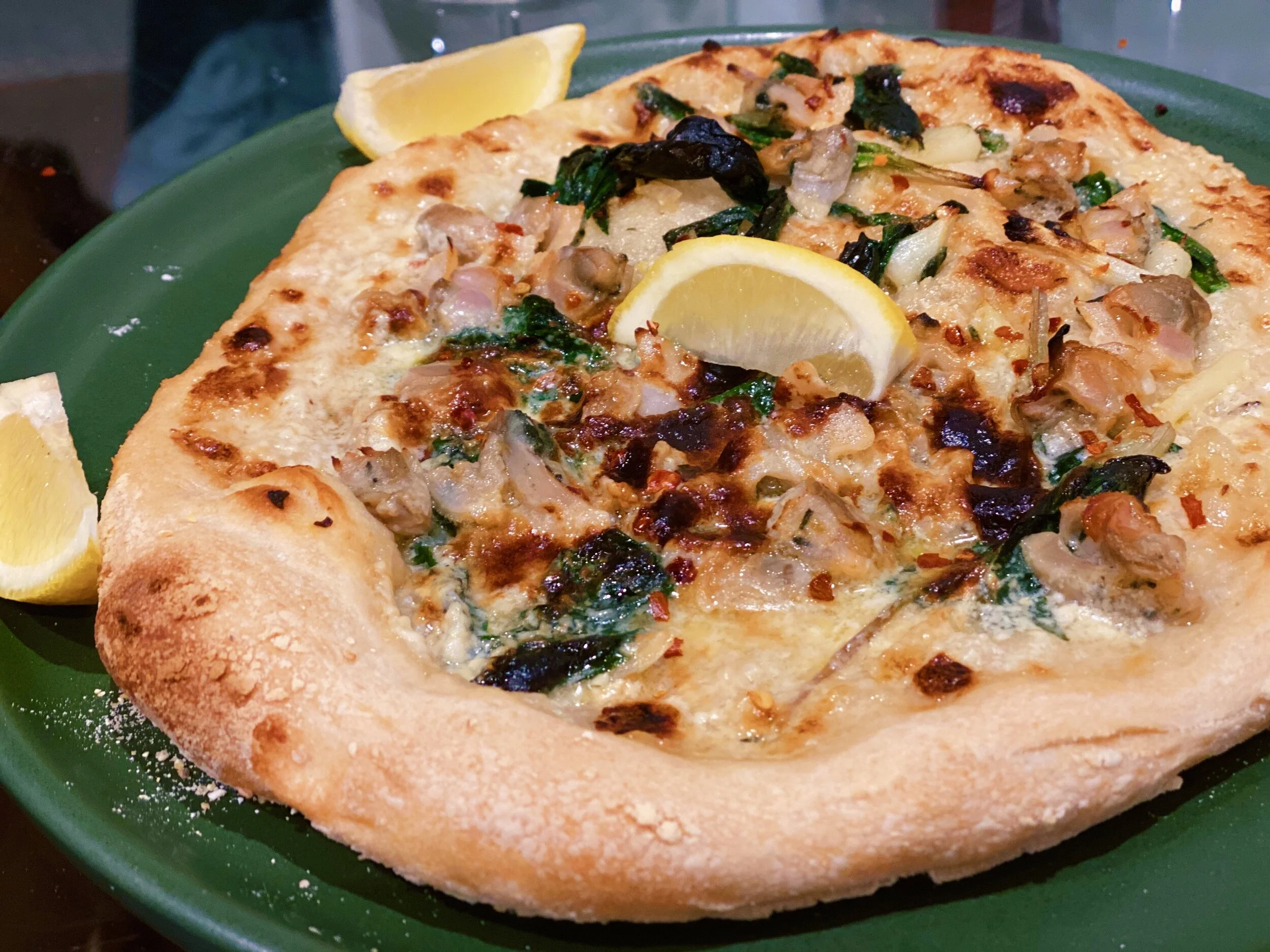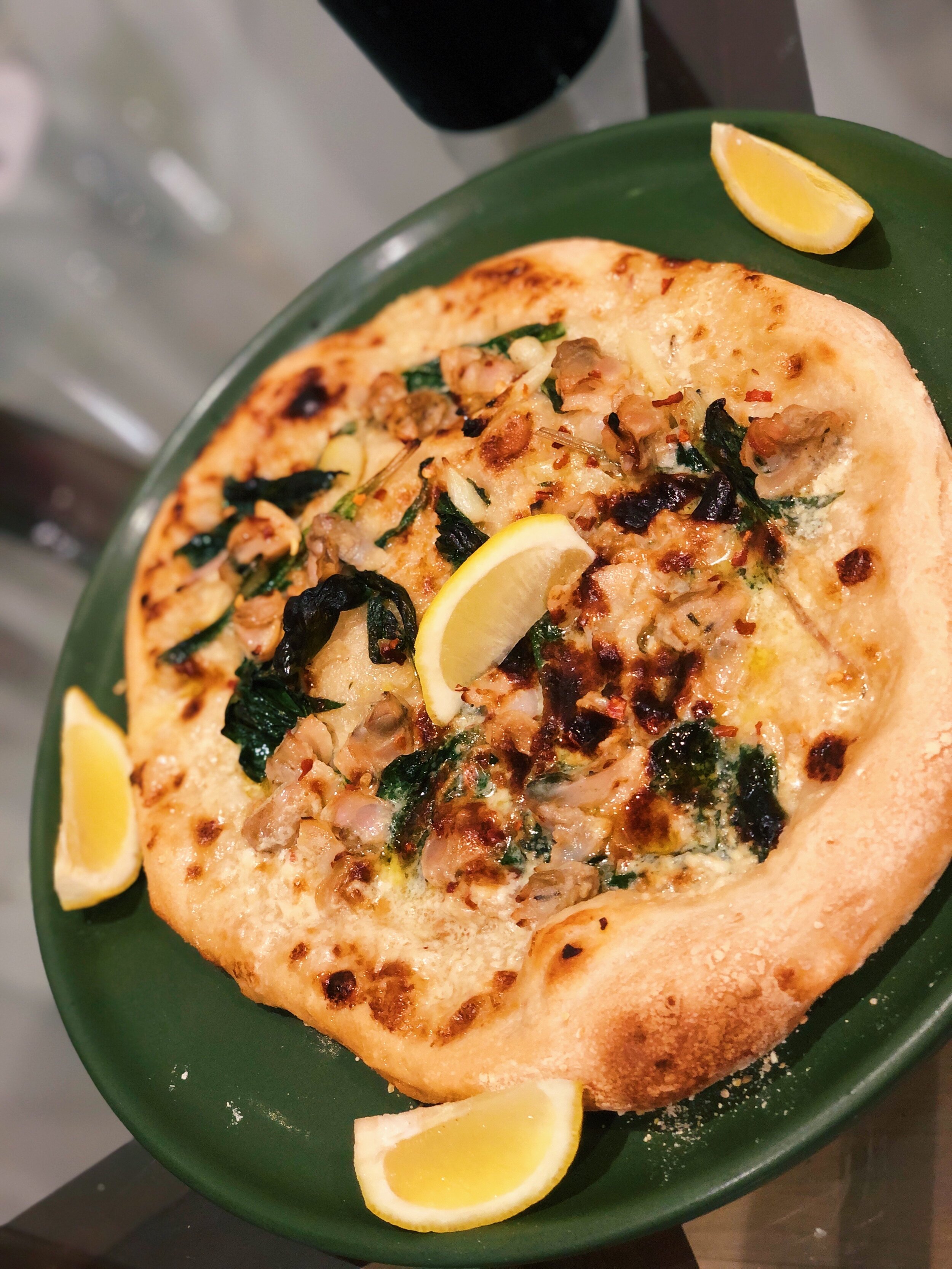Pizza with Clam and Ramps
The sun had just set beyond the white chalk cliffs of Étretat and we were starving. It was a five-hour drive back to the chateau (and I was getting married the next day), so we only had time for a quick bite before hitting the road. It being August, business hours were truncated everywhere in France. In the waning light, the only place we found open was a little pizzeria by the parking lot. I plonked myself onto a vinyl chair in my crimson gown. We ordered a round of pizzas. Luigia and her husband Giuseppe, both from southern Italy, prodded skeptically at the pies when they arrived.
Never trust the French with pizza, we learned. The tomato sauce tasted like watered-down ketchup; the crust seemed to be a large, soggy cracker. We ate ravenously out of haste and necessity, but I think the experience may have permanently scarred the Italians.
I got to know Luigia and Giuseppe of Evergreen Film while planning my wedding. In an ocean of formulaic, saccharine wedding media, their work sprang from the screen and played on loop in my mind for weeks. Their filmmaking gets under the skin of a moment of high artifice. In weddings, love is molded and squashed into the shape of someone else’s traditions—the speeches, the clothes, the rituals, all of these can be lovely but they are a pantomime of romance. Luigia and Giuseppe’s videography lays bare the soul of a relationship—something you may or may not be ready for in a wedding video. The film they made of mine is astonishing, with moments reminiscent of the reveries of Chris Marker, the velvet brutality of Ingmar Bergman, the cheeky playfulness of David Lynch. It’s a vision of wild beauty, shot through with a mournfulness that can be hard for me to witness. Can that really be us? How did they know? I wonder, as I watch.
In the years since, Lu and I have nurtured a friendship across a distance. We share a love for glossy green jungle plants and avant-garde film. We texted each other when Jonas Mekas passed away; I tracked down a rare copy of Stan Brakhage’s dream journal for her. In late February this year, as coronavirus transformed life in Italy, she texted me about how she and Giuseppe were coping. Overnight, all of their upcoming wedding jobs were cancelled; like so many creatives around the world, they had lost their source of income and were staring down a murky future.
On March 7th, she wrote that even in their town in southern Calabria, hospitals were becoming overwhelmed. At the time, the pandemic still felt remote in New York City (where we convince ourselves that even the opposite side of Manhattan is ‘far’). Cases clustered in Queens and New Rochelle seemed sufficiently distant. I went to a women’s event on the 10th where we ate elbow to elbow at a tiny table in a packed restaurant. That night as I rode an Uber home I saw a message from Luigia—a warning from the future: “Please do everything you can to protect yourself and your loved ones,” she wrote. Tired and tipsy, I stopped by the grocery store and stocked up on supplies. That week, New York City shut down.
Most of us have one person, one experience, one news story that finally nudged us over the line from denial to realism on COVID-19. My person was Lu. She convinced me to take it seriously, and together my sister and I convinced our parents in Canada. On March 14th my dad, chairman of the board of his church, cancelled Sunday service and the congregation of a hundred people (most over the age of 60) stayed home. What felt paranoid at the time now seems like a no-brainer, and I will always be grateful to Luigia for my family’s sake.
Captivity has blurred the boundaries of time but it has also altered space. The distance from my apartment through the lobby to the outside world, which my dog and I traverse several times a day, feels suddenly expansive. The drive to an upstate park (an inconvenience I would have avoided in the days of traffic) now seems negligible—a small price to pay for fresh air and freedom. The distance between me and all of my friends and family has suddenly become equal. My book club, which formerly disbanded when members scattered to London, DC, and LA, has now reformed on Zoom, spanning all eight time zones, because why not? We’re all going nowhere.
Lu doesn’t feel like a distant friend, she’s as near and as far as anyone in my life. Recently she posted a mouthwatering photo of a pizza she’d made. We laughed about the horrific French cracker pizza, and she sent me her wonderful recipe below, which yielded a crispy, pillowy crust. Making my friend’s recipe and showing her the photos felt like we were sharing a meal. In the way of the new world, we were.
*
A note on toppings: Margherita, speck and radicchio, sausage and mushroom—anything goes (except for pineapple, Luigia notes). Clam is not a traditional pizza topping in southern Italy, but it tastes like it should be. The brininess of the seafood, a bright squeeze of lemon, and a heavy drizzle of Calabrian chili oil certainly evoke languid summer evenings on the Amalfi coast. The topping recipe below is adapted from Pasquale Jones, one of my hands-down favorite restaurants in New York (for the clam pie, Zalto wine glasses, and Lupe Fiasco deep cuts on heavy rotation).
FYI I’ve included rounded baker’s percentages below, in case you want to make more or fewer pies!
Pizza with Clam and Ramps
Makes 4 small pizzas
Pizza Dough
350g all purpose flour (or finely milled “00” flour if you can find it) - 70%
150g bread flour (in Italy this is called “Manitoba” flour because high-gluten wheat originally came from there) - 30%
350g warm water (between 105-115˚F) -70%
5g fine sea salt - 1.5%
4g sugar (1 tsp) - 1%
10g extra virgin olive oil - 3%
3.5g active dry yeast (half a regular packet) - 1%
In a large bowl, mix the two types of flour.
In a small bowl, dissolve sugar in warm water. Sprinkle the active dry yeast over the surface and let the yeast bloom for 5-10 minutes.
Dissolve the salt in a little hot water and pour it into liquid (after it has bloomed, or else it will stilt the yeast blooming).
Slowly add the liquid to the flour (I use a fork) and mix to incorporate all the flour. The dough will be very hydrated, very mushy, but don't worry. For baking in a home oven (which doesn’t get as hot as a wood-burning pizza oven) you want the dough to be very well-hydrated so that it doesn’t dry out during the longer baking time.
Finally add the oil and continue to knead, now with wet hands. Knead from the bottom to the top of the bowl so that the mixture takes a lot of air. If you find it too sticky, sprinkle your hands with flour. Pizzaioli have a charming expression for this: “lavarsi le mani con la farina”—washing your hands with flour.
After about 10 minutes of kneading, cover the bowl with plastic wrap and let this mixture rest for an hour.
Sprinkle your hands with flour, flour a clean surface, and slide the dough onto the surface.
Knead for another 15-20 minutes. Knead by pushing the dough away from you, folding it in half, turning 90 degrees, and repeating. Return the dough to the bowl, cover the bowl with plastic wrap, and put it in the fridge for 8-24 hours. The longer you let it rest, the more developed its flavor will be.
After removing from the fridge, divide the dough into portions of about 200-250g. Form into balls, then allow them leaven out of the fridge for another 6 hours. Prep your toppings in the meantime (see below for clam topping recipe).
To bake, preheat oven to 500˚F (hotter, if your oven can handle it). If you have a pizza stone, preheat this inside your oven. If not, a baking sheet will work too.
Sprinkle some semolina flour on a clean surface and flatten each ball into a round (don’t use a rolling pin, just pull it gently with your hands). If you can spin dough over your head, go for it! Don’t worry about making a perfect circle, these are meant to be quite rustic.
Brush the crust all over with olive oil, then add the toppings of your choice. Slide onto a hot pizza stone or a baking sheet. Each pizza will take 6-9 minutes to cook.
Clam Topping
For 4 small pizzas (halve if you want your pizzas with different toppings)
2 tbsp olive oil
5 cloves garlic, minced
Small bunch of ramps, sliced into 2” segments (if it’s not ramp season, substitute with broccoli rabe!)
20 littleneck clams
2 tbsp olive oil
1 shallot, minced
2 parsley stems
1 sprig of thyme
1/2 cup dry white wine
1 cup heavy cream
1/4 cup parsley leaves, finely chopped
1/2 tsp crushed calabrian chilis (or red pepper flakes)
Lemon wedges, for serving
Rinse and scrub clams thoroughly in cold water. Fill a bowl with cold water, sprinkle a little salt in it, and transfer clams into this bowl; avoid pouring them from one vessel (even a colander) into another or you’ll transfer grit to the soaking bowl. Soak for 30 minutes in the fridge. Rinse again and repeat this process if you found a lot of grit in the bowl.
Heat 1 tbsp olive oil in a pan over medium heat. Sauté ramps very briefly until the white bulbs are softened and leaves are just wilted
In a large pan with a tight lid, heat 1 tbsp olive oil and sauté garlic, shallot, parsley stem and thyme sprig until the shallots are translucent. Add white wine and place the clams in the pan. Cover and steam for 5-7 minutes until the clams just open.
Transfer clams to a bowl and reduce the cooking liquid for about 10-15 minutes or until it’s thickened. Transfer to fridge and let this cool completely.
Remove the clams from their shells; chop roughly if you have larger clams.
In a medium bowl, whip the heavy cream to a soft peak, then gradually add the reduced clam liquor. Whip to a medium peak. Taste and season if necessary (usually extra salt isn’t needed because the clam cooking liquid gets quite salty, but use your judgement).
To assemble pizza, brush the flattened dough with olive oil (all the way to the edge) and spread a generous layer of the cream over the middle, leaving a border of about an inch. Spread clams evenly over the surface and add sauteed ramps, sprinkle with a tbsp of parsley and chili flakes. Slide onto a hot pizza stone or a baking sheet and bake until the crust is golden (I like to push it to charred). Each pizza will take 6-9 minutes to cook. Serve with lemon wedges and Calabrian chili oil.
Displaced Dishes
Displaced Dishes is a compact cookbook featuring 30 delicious recipes from displaced people who’ve found themselves at a refugee camp on Samos Island in Greece. Residents of the camp recounted their favorite recipes to volunteers; these recipes come from Iran, Burundi, Syria, Iraq, Algeria, Kuwait, Greece, Palestine, Afghanistan, Djibouti, Kurdistan and Egypt. 100% of the profits from the sale of this book go towards providing services for residents of the Samos Refugee Camp. The residents of camps like this are especially vulnerable to COVID-19, so your support is especially crucial now. If you’re looking for cooking inspiration, this is a wonderful place to start. Thanks to PK for sharing this with me!




